Gardening should be a pleasurable activity but it is not without its hazards. Staying safe in the garden can be as simple as not overdoing it and wearing protective gear but taking care of yourself and making sure you are up to the job can also make a big difference when it comes to reducing the risk of injury when working in the garden.
Hurting yourself is never fun and while back injuries are a common gardening complaint, they can be avoided or reduced by doing some gentle warm-up exercises before you start. Stretch your back regularly while gardening, take frequent rests, avoid uncomfortable working positions and bend at the knees when lifting heavy pots or bags of compost, or seek help if the object is too heavy.
Let's take a closer look at how protective gear, using equipment safely and keeping an eye out for critters can also help keep you safe while you're gardening.
Protective Gear
1. Skin
In Australia, being sun-smart is key to protecting yourself against skin cancer. It is a very real problem in our sunny land and although some skin cancers may be benign, many are not, so protecting your skin, whether you're out in the garden or down at the beach remember to "slip, slop, slap, seek and slide" - slip on a shirt, slop on some sunscreen, slap on a hat, seek shade, and slide on some sunglasses.
Wearing protective clothing such as long-sleeved shirts and trousers will also help protect your skin from scratches and insect bites, and don't forget to drink plenty of water too, especially if it is a hot day.
2. Eyes
Sunglasses are a good idea to protect your eyes against the sun's rays while out in the garden, but if you're using a chainsaw, hedge trimmer, whipper-snipper, lawn mower, or anything else that can cause flying debris, then safety goggles or a face shield are a better option for protecting your eyes.
Safety goggles will prevent dust and debris from blowing into your eyes, and being more robust snug-fitting than sunglasses, they can protect your eyes from larger particles penetrating your eyes, as well as puncture injuries. Eye injuries can easily occur if you don't see a garden stake and lean over it, or if you get poked in the eye by a branch or stick from a shrub. It is also a good idea to wear safety goggles when pruning things that may be above your head as falling plant material and debris may land in your eyes.
There are many different types of safety glasses and goggles to choose from, and it may help to have a couple of types on hand to suit the task you're doing. Most goggles are designed to fit over spectacles and some have vents to prevent fogging and heat build-up.
3. Ears
Petrol driven garden equipment such as lawn mowers, leaf blowers, and weed eaters/whipper snippers all make a noise. While they may be quintessential summer sounds, operating noisy equipment like this, especially for sustained periods, can damage your hearing.
Ear defenders, ear muffs, or ear plugs are designed to considerably reduce the amount of noise reaching your eardrums, and can also make these noisy tasks more pleasurable. Ear protection usually comes with a decibel (dB) rating which indicates how much noise reduction the product offers when being worn, and the range of protection offered is usually in the region of between 15 to 30 dB.
Ear plugs generally offer a greater level of protection as they fit right into the ear canal and are suitable for very high noise environments. They are also more convenient for people who wear spectacles and can be more comfortable than ear muffs in hot weather. If you choose to wear earplugs be sure to either use disposable ones, or make sure you disinfect them regularly if you wear them over and over again. This helps prevent the buildup of harmful bacteria that can cause ear infections which could lead to internal ear damage or hearing loss.
4. Hands
Use gardening gloves to protect your hands against cuts and abrasions, insect bites, skin irritants, or pathogens that may be present in the soil or potting mix.
Cotton gloves are ideal for lightweight gardening jobs such as deadheading and potting, and will also protect your hands from the sun. Leather gloves are the go-to for heavy work such as grabbing branches, or when working with stones, rocks, or pavers. All-purpose gloves constructed of breathable fabric and coated in latex, or other rubberised material, provide a good grip, as well as a cut and puncture-resistant surface. Their flexibility allows for greater manual dexterity so they're easy to wear and perfect for tasks like weeding or potting. If you're working with seeds or seedlings then closer-fitting disposable nitrile, latex or vinyl gloves allow you to feel what you are doing while still protecting your hands. Always use rubber gloves when working with chemicals and sprays.
Even if you are wearing gloves, it's also a good idea to keep up to date with your tetanus vaccinations as cuts and puncture injuries carry the risk of tetanus. And of course, remember to wash your hands and scrub your nails after handling soil or working in the gardening.
5. Lungs
Wearing a mask or respirator to filter out airborne particles is a must for some jobs in the garden. Airborne particles include dust, pollen, fungal spores, airborne bacteria, and other particulates and fumes.
If you're a gardener who suffers from seasonal allergies caused by grass and tree pollen, then wearing a mask that filters out these particles will make your job far more enjoyable.
Airborne bacteria can be found in potting mixes, so make sure to open bags of potting mix in a well-ventilated area. Open the bag away from you and whether the mix is damp or dry, avoid breathing in the air from the bag. Also take care when turning over, or working with, compost to avoid breathing in airborne fungal spores.
Simple dust masks help to reduce the amount of dust you might inhale when mowing lawns but proper respirator type masks should be used when mixing and applying spray chemicals.
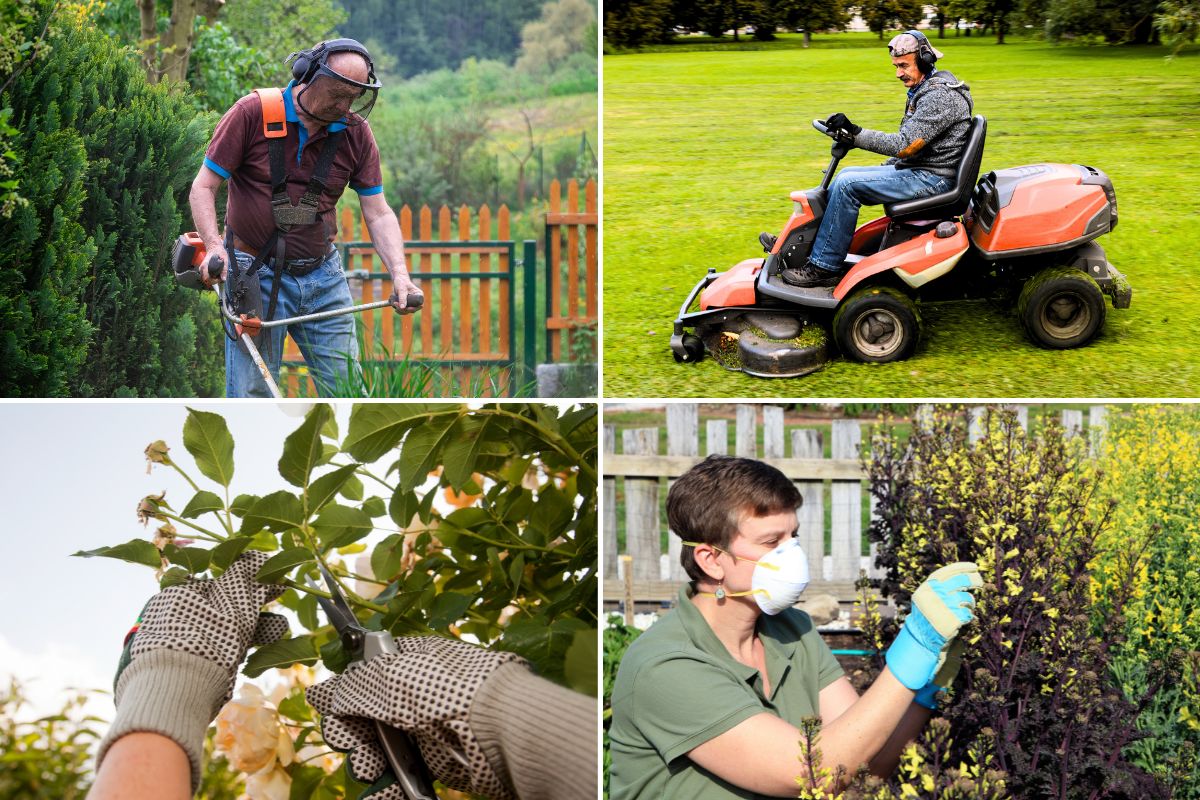 Face shields protect against flying debris; ear muffs are a good idea when using noisy equipment; gloves protect against scratches as well as the sun; wear a mask if you have allergies
Face shields protect against flying debris; ear muffs are a good idea when using noisy equipment; gloves protect against scratches as well as the sun; wear a mask if you have allergies
Using Equipment Safely
1. Hand tools, secateurs, forks, spades, rakes etc.
To avoid repetitive stress injuries and fatigue, use the appropriate tools for the job. This means choosing tools that are comfortable to hold and use, and don't use tools for purposes other than for what they were intended because there is a chance you may damage the tools or cause injury to yourself.
Avoid carrying sharp or pointed tools such as secateurs in your pocket - use a holster that clips onto your belt instead. It will keep them safely out of the way but they'll still be close at hand.
2. Ladders
A fall from a ladder can cause very serious injuries so ensure your ladder is properly secure before you stand on it. Don’t stand on the highest rungs of a ladder either as there is an increased chance of it tipping over, and maintain at least three points of contact while standing on a ladder.
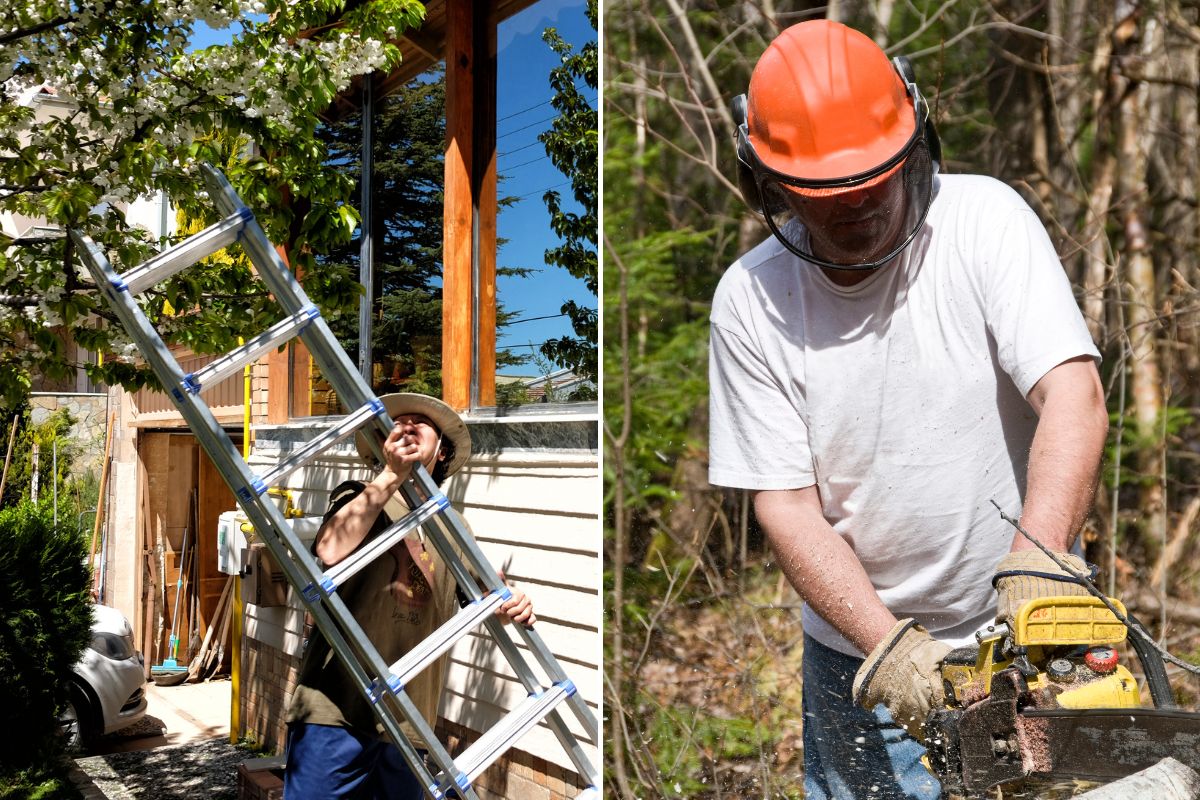 Use equipment safely and learn how to use tools you're not familiar with to reduce risk of injury
Use equipment safely and learn how to use tools you're not familiar with to reduce risk of injury
3. Chainsaws, hedge trimmers and other tools with blades
Using and operating a chainsaw looks quite easy but not having proper training on how to use one safely can lead to serious injuries. Cutting injuries are common and occur from kick back, pull in, or when sharpening the chain. Falling branches cause crush injuries, and eye injuries can result from flying debris and sawdust.
Learning about the chainsaw you are using, as well as safe operation procedures, proper risk assessment and wearing appropriate protective gear, all go a long way to reducing accidents and injury. The same goes for any other tools and equipment you use that involves blades and cutting edges.
4. Lawn mowers, weed eaters and brush cutters
Some of the most common injuries caused by lawn mowers are open wounds and fractures to the bones of the hands and feet. Wearing enclosed shoes, preferably safety boots with steel toe caps, when operating a lawn mower or grass trimmer can reduce the risk of this type of injury occurring, and wearing long trousers made of sturdy fabric will help protect your legs. Avoid foot injuries by taking extra care when mowing slopes or when pulling a mower towards you.
Eye injuries can also occur when sticks and stones are flung up by mower blades, or weed eaters, so wear eye protection such as safety goggles or a face shield.
Don't forget that lawn mower engines get hot, so avoid burns by being careful not to touch hot parts!
Many electrical mowers and line trimmers now run on batteries but if you have a corded electric mower or trimmer take care not to run over the electric cord.
If you have a ride-on mower, drive at slow speeds especially when turning as they can have a tendency to tip over.
5. Sprays and chemicals
Always wear appropriate personal protective equipment (PPE) when mixing and handling sprays and chemicals. This is because exposure, contamination and poisoning by pesticides and herbicides can occur through ingestion (swallowing), inhalation (breathing) or absorption (direct contact) via the skin and eyes.
Your eyes and skin are the most exposed surfaces, so cover up by wearing a long-sleeved shirt and trousers, or a washable coverall, chemically impervious gloves and footwear, goggles and appropriate facemasks or a respirator. Respirator cartridges should provide multi-level gas protection.
Remember that when you are mixing up chemicals you will be working with a concentrated product, so even more care is required than when applying it.
The safety data sheet on the product you are using will have instructions on how to safely dispose of leftover sprays and hazardous chemicals. Be sure to read this part of the label before mixing up any chemicals so you know what to do in case of a spill, and what you need to do to dispose of any leftover spray or chemicals safely.
If you can't find instructions on the packaging (they may have been worn or rubbed off), contact your local council or EPA (Environmental Protection Authority) to find out how you should treat and dispose of such chemicals. A licensed waste treatment company should dispose of large quantities of leftover spray or any unwanted liquid chemicals.
Clean and maintain your PPE after use, and wash contaminated clothing separately from the rest of your household laundry.
Most importantly, always read the label and safety data sheet first before handling pesticides, herbicides and other chemicals, and wash your hands thoroughly after handling any chemicals.
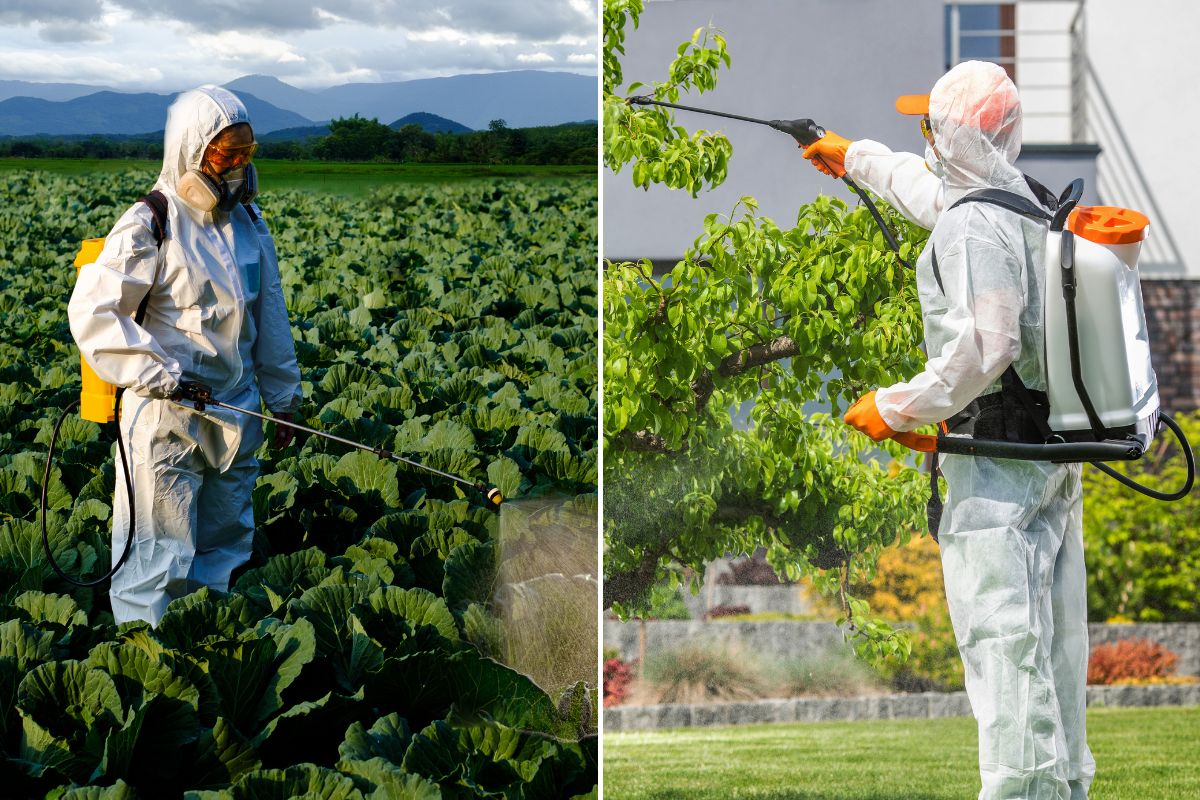 Wear appropriate PPE (personal protective equipment) when working with sprays and garden chemicals
Wear appropriate PPE (personal protective equipment) when working with sprays and garden chemicals
Staying Safe Around Garden Critters
Gardens are not only havens for humans but for wildlife as well. Some wildlife, like biting or stinging insects such as mosquitoes, bees, wasps and sand flies/biting midges, as well as spiders and snakes, can not only cause annoyance and irritation, but their stings and bites can also be life threatening. Being aware of wildlife you may encounter in your garden means you can avoid certain areas when flowering plants may attract various insects to your garden, or you can take appropriate action to prevent bites and stings.
Biting and Stinging Insects
Mosquito bites can be avoided by wearing long sleeves and trousers and using insect repellents when gardening. If you have lots of mosquitoes in your garden, look for any sources of stagnant or still water where they may be breeding. Simply removing places where they breed can often dramatically reduce the number of these insects in your garden.
Sand flies or biting midges are other annoying biting insects you may come across in your garden. The itch from these bites can be worse than those from mosquitoes as it lingers for days, and in some people the bites can cause quite a severe reaction. Sand flies or biting midges can occur in moist or damp areas in the garden, like mulched pathways, so avoid activities such as watering and gardening during the early morning and late afternoon when midges are most active. Covering up with protective clothing and applying insect repellent can help reduce the chance of being bitten. If you are bitten, apply an antihistamine cream or lotion, or for a severe reaction an antihistamine pill may be required. Avoid scratching the bites as the risk of a secondary infection is higher if the skin is broken.
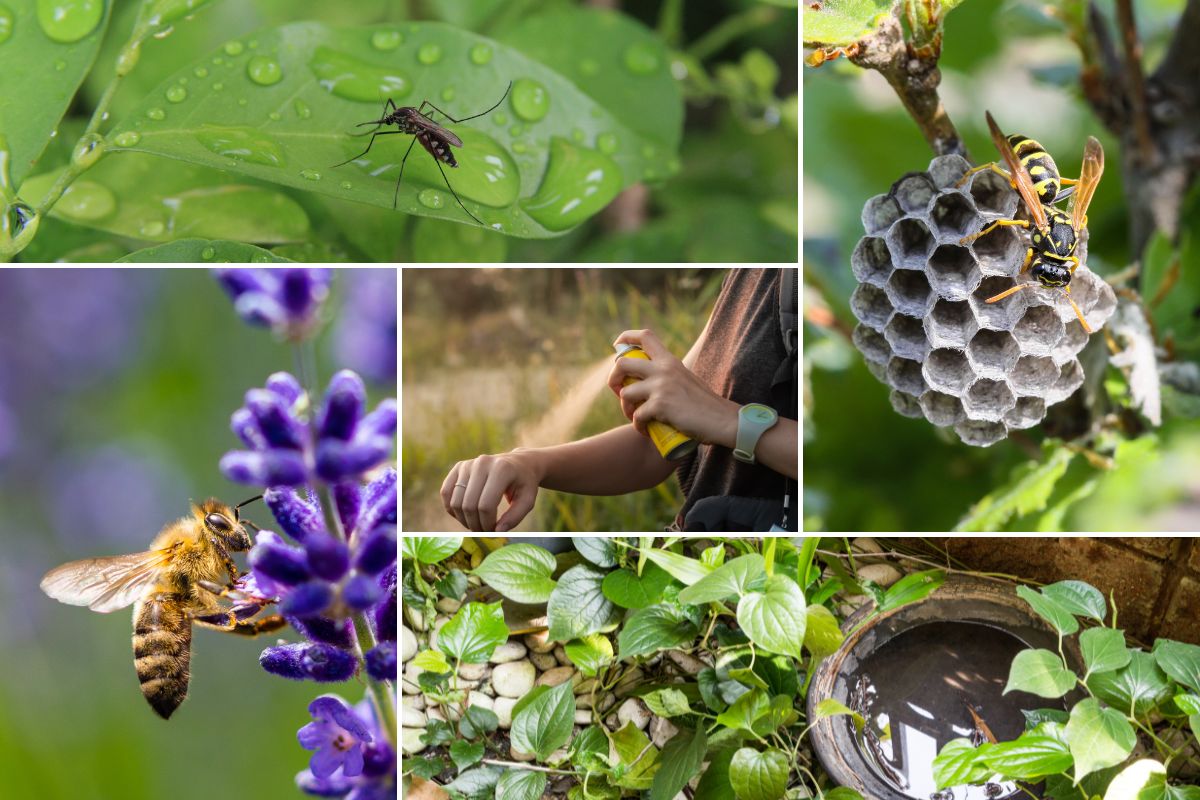 Remove potential breeding grounds for mosquitoes, and wear insect repellent to ward off other biting or stinging insects
Remove potential breeding grounds for mosquitoes, and wear insect repellent to ward off other biting or stinging insects
Spiders
Not all spiders are dangerous and most are harmless and even beautiful. In the garden you'll find spiders on plants and trees, underneath logs, dense shrubs, pots, bird baths, rocks and pavers. You'll also come across them on fencing, and around the house up near the eaves, and along window and door frames.
To avoid being bitten by spiders while working in the garden, the simplest thing to do is wear gloves and closed shoes. Check underneath or around garden furniture and logs before sitting down, and when moving pots, rocks or other items, carefully lever it away from you first before checking to see if a spider isn't sheltering under it. Some people like to leave their shoes outside before going indoors, so if you do this remember to check your shoes for spiders before you slip them on.
Snakes
Being prepared, and educating yourself about your local snake species will help you know what to do if you encounter one in your garden. Not all snakes are venomous, so learning about their habits, where they like to live and how potentially dangerous they may be is key to staying safe and living alongside snakes that you may come across.
Snakes will always look for places where they can shelter or hide, so keeping your garden tidy reduces the opportunity for snakes to take refuge in your garden. Prune shrubs and mow your lawn regularly because tall grass and overgrown vegetation provides good cover for snakes. If you have stacks of bricks, planks, logs, or other building material and machinery in your garden, take care when moving it because the dry nooks and crannies are perfect spots for snakes to hang out.
Snakes will also come into your garden looking for food, so avoid leaving pet food out, and control rat and mice populations because snakes will readily eat these introduced animals.
Wear gloves, sturdy shoes and trousers when working in the garden, especially if you know there may be snakes about, and also make sure you know what to do, and who to call in case of an accidental snakebite.
Stay safe out there and happy gardening!
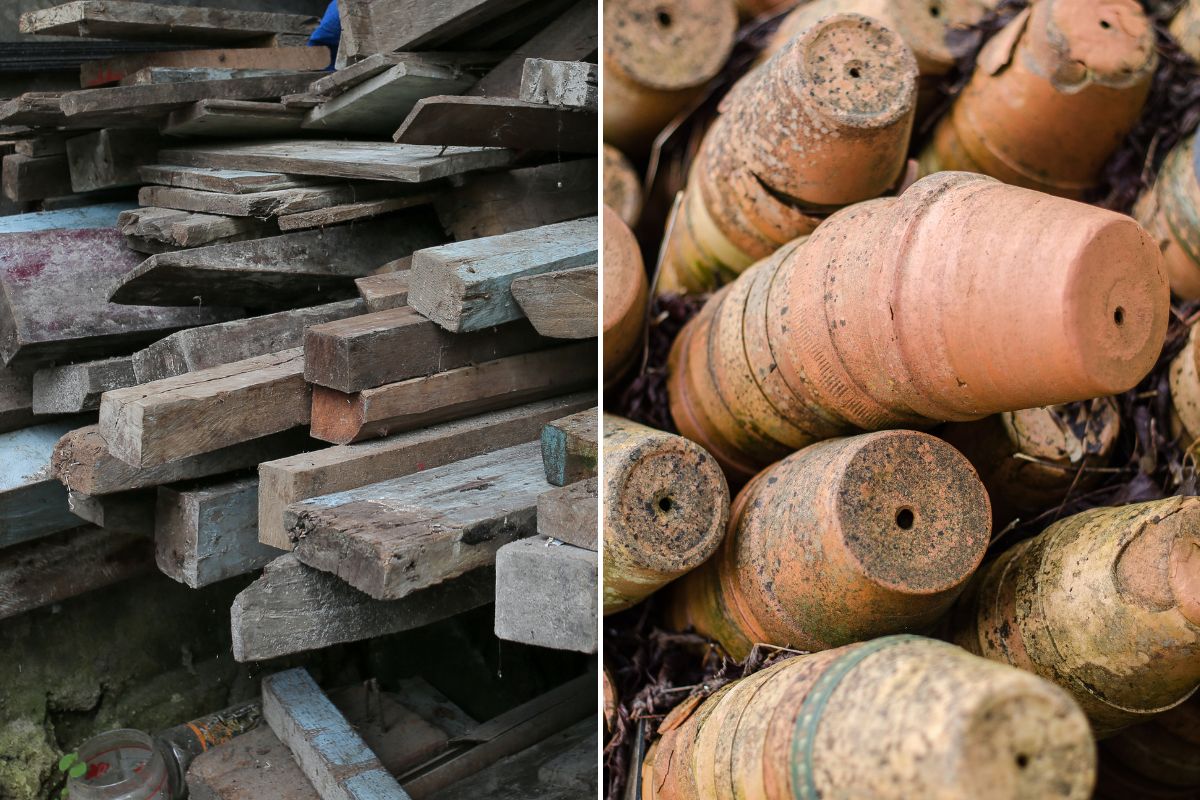 Stacks of planks and pots provide good places for spiders and snakes to find refuge and shelter
Stacks of planks and pots provide good places for spiders and snakes to find refuge and shelter





